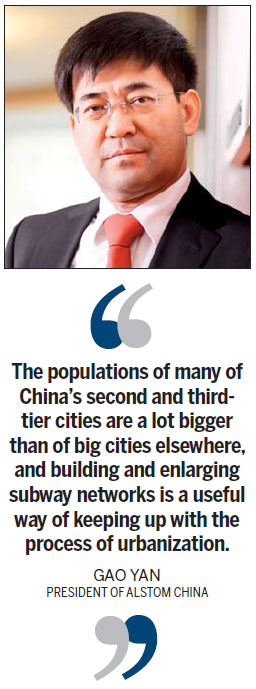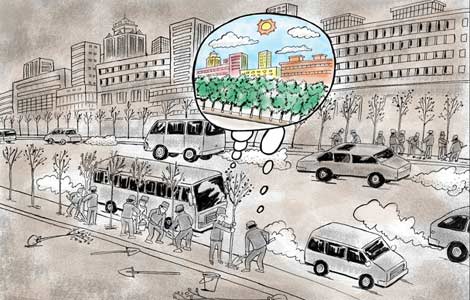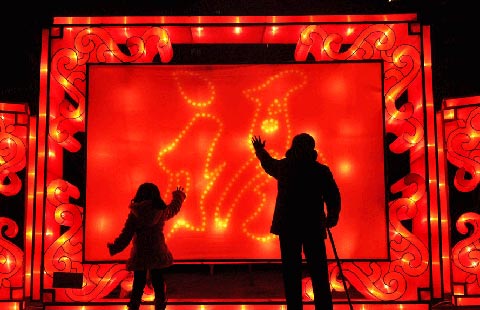French giant powers underground
Updated: 2014-02-14 08:50
By Zhong Nan (China Daily Europe)
|
|||||||||||
|
Installation of the upper bracket of a 800 mW power unit in China made by the French company Alstom. Provided to China Daily |
Subway trains seen as one way of reducing environmental problems
The transport infrastructure and power generation conglomerate Alstom SA has won its first batch of metro contracts in western China, marking a strategic breakthrough for the company in the country.
The two contracts, worth a total of 75 million euros, are to supply new traction equipment for more than 550 carriages in the Chengdu and Xi'an subways from next year.
The company will provide a traction system designed specifically for China said to improve acceleration and deceleration, reducing travel time and resulting in greater frequency of trains.
The equipment will be made in China by Shanghai Alstom Transport Electrical Equipment Co and supported by Alstom's design unit in Charleroi, Belgium.
Gao Yan, president of Alstom China, says many of the opportunities it is being presented with arise from China's urbanization. Many cities, partly to reduce pollution caused by choked roads, are upgrading their rail systems, including extending their subways or building new ones.
By 2020, Chengdu, capital of Sichuan province, plans to have 10 subway lines covering 350 kilometers, and by 2018 Xi'an, in Shaanxi province, plans to have six subway lines. At present both cities have just two lines each.
Dominique Pouliquen, senior-vice president of Alstom Transport Asia Pacific, says: "Based on the regional characteristics, our investment will be in areas that have strong market growth potential and function to further stimulate domestic consumption to meet the demand for urbanization."

Alstom has set up an office in Chengdu to coordinate its activities across the region, and in Xi'an the company has a joint venture, Xi'an Alstom Yongji Electric Equipment Co, which makes, assembles, tests and warrants traction motors.
By the end of last year Alstom had supplied more than 1,600 subway carriages to China and provided traction systems for more than 1,400 subway carriages in Chinese cities including Beijing, Hong Kong, Nanjing, Qingdao and Shanghai.
The National Development and Reform Commission, the country's top ecomomic planner, approved subway construction projects in 23 Chinese cities during 2012 and 2013, with a total investment of 840 billion yuan ($134 billion; 101 billion euros).
A further 21 railway, highway and port projects, 10 environmental protection projects, 76 clean energy projects, and several hydropower station and airport construction projects have also been approved in the past two years.
Sun Fuquan, a researcher at the Chinese Academy of Science and Technology for Development in Beijing, says: "Even though China's GDP growth was lower last year than previously, public transport and other infrastructure investment obviously add to prosperity, and both benefit the economy and the environment in the long term."
The importance of improving the environment was underlined by figures from the Ministry of Environmental Protection in November that showed 70 percent of Chinese cities failed to meet new air quality standards.
China thus needs to vigorously develop subway and tram systems in big cities to keep the numbers of cars on the road down, Sun says. It also needs to promote better fuels, eliminate high-emission vehicles and adopt and enforce higher emissions standards, he says.
Gao says: "The populations of many of China's second and third-tier cities are a lot bigger than of big cities elsewhere, and building and enlarging subway networks is a useful way of keeping up with the process of urbanization."
Alstom entered China in 1958 and has since supplied products and technical solutions from locomotives to power plant technologies. Alstom China employs 9,000 people in more than 20 commercial entities across the country. Alstom Group says it booked 23.8 billion euros of orders from the global market in its 2012-13 fiscal year, up 10 percent from the previous year.
Gao says the company will invest in renewable power, particularly hydropower, as the country deals with pollution and tries to repair the environmental damage wrought by rapid expansion in many areas, such as the steel and cement industries.
The focus on hydropower and other clean energy comes as China tries to reduce the use of fossil fuels and to cut carbon dioxide emissions by 17 percent per unit of GDP by the end of next year.
Last year Alstom completed an upgrade and expansion costing 100 million euros of its Tianjin hydro plant, the company's largest hydro plant in China. It employs 2,000 people, including 400 engineers. There are 19 critical heavy machines including two new gantries. It will be able to deliver up to 26 turbine and generator units a year, the company says.
To improve the research and development needs of the Asian market for various types of hydropower equipment, Alstom has also set up a global technology center, its activities including research and development in mechanics, hydraulics and electrical requirements for hydropower turbines and generators as well as scale model tests of different turbines.
Alstom provided four high-power hydroelectric generating units to Xiangjiaba underground hydro power plant in Yunnan province last year that were designed and made in Tianjin.
Under the energy development section of China's 12th Five-Year Plan (2011-15), a goal has been set for the country to become the largest generator of hydroelectricity. The country will further promote hydropower, and by the end of next year the capacity of conventional hydropower is scheduled to reach 260 gigawatts and of pumped storage power stations 30 gW.
Liu Shukun, a professor at China Water Resources and Hydropower Institute in Beijing, says that since the Fukushima nuclear disaster in Japan in 2011, governments have been keen to push ahead with all forms of renewable energy: solar, wind, bio-energy, geothermal and hydro.
However, the development of wind and solar energy is slowing. The State Council began tightening approval for wind power projects at the end of 2011 after many wind resources were wasted because the grid could not transmit their electricity.
Hydropower makes up 22 percent of China's installed power base, with many large hydroelectric projects being planned or built
"China's hydro market is in good shape," Liu says. "Installed capacity for hydropower is increasing 15 gW every year and is expected to reach 380 gW by 2020 from less than 200 gW in 2013."
The country also plans to draw 11.4 percent of its energy from renewable sources by the end of next year, of which hydropower will contribute two-thirds, the National Energy Administration says.
zhongnan@chinadaily.com.cn
(China Daily European Weekly 02/14/2014 page20)
Today's Top News
Germany, France eye new data network
No much progress in Syria peace talks
Lantern Festival fires kill 6 in China
China urges US to respect history
KMT leader to visit mainland
11 terrorists dead in Xinjiang
Illegal detention reports probed
4 die in Austrian train-car crash
Hot Topics
Lunar probe , China growth forecasts, Emission rules get tougher, China seen through 'colored lens', International board,
Editor's Picks

|

|

|

|

|

|






